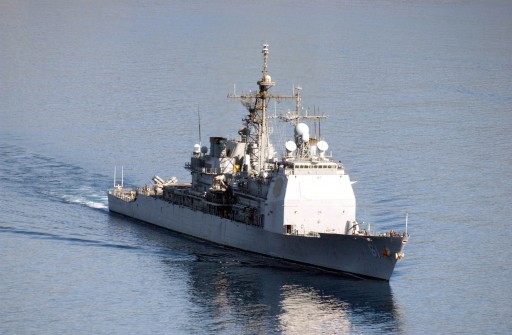 Norfolk, VA – A warship capable of detecting and shooting down ballistic missiles headed for the Mediterranean Sea on Monday as the U.S. started implementing its plan to protect Europe from a potential Iranian nuclear threat.
Norfolk, VA – A warship capable of detecting and shooting down ballistic missiles headed for the Mediterranean Sea on Monday as the U.S. started implementing its plan to protect Europe from a potential Iranian nuclear threat.
Subscribe to our Daily Roundup Email
Sending the Norfolk-based USS Monterey to Europe is the first part of a four-phase plan to create a missile shield for the continent that was developed by the Obama administration in 2009 and approved by NATO in November.
The plan calls for placing land- and sea-based radars and interceptors in several European locations over the next decade and has drawn opposition from Russia, which worries the system could target Russian warheads or undermine their deterrence strategy.
The Missile Defense Agency and the U.S. Navy have modified 21 ships with a radar system capable of tracking ballistic missiles. Most of those ships are based in the Pacific, but the U.S. successfully conducted its first ballistic missile tracking exercise in the Atlantic in January.
That test involved the Monterey and two other ships.
Other ships capable of ballistic missile defense have been deployed by the U.S. to the Mediterranean since 2009, but this is the first to go under the new defense plan known as the European Phased Adaptive Approach.
“We’re going to do a lot of stuff that hasn’t been vetted out and we’re going to help vet it out, so it’s not your mother’s deployment,” Capt. Jim Kilby, the Monterey’s commanding officer, told The Associated Press in an interview.
The Monterey is a guided missile cruiser equipped with a sophisticated Aegis radar system capable of short and medium range ballistic defense. Kilby said part of the ship’s job on its six month deployment will be testing out a variety of scenarios that could affect other ships sent to protect Europe in the future.
“The piece that’ll have to be understood by folks is there’s a limit to what one ship can do,” he said. “So we need to ask for another asset, potentially, if we’re worried about multiple things or launches. And that’s the piece I think we’re going to help define.”
In phase two of the plan, land-based interceptors would be deployed in Romania in 2015, followed by the placement of interceptors in Poland in 2018. Each phase calls for a more sophisticated and capable interceptor, culminating at the end of the decade with the deployment of the last version planned at this time.
While not part of the initial phase, Kilby noted the Monterey is capable of tracking ballistic missiles at long ranges and transferring that information to ground-based missile defense sites capable of shooting them down.
That capability was primarily designed to handle threats in the Pacific, he said, but will eventually be transferable.
“There is kind of a tactical handoff part of this that will eventually become part of the capability of the EPAA as it matures, so that will be understood too,” he said.
